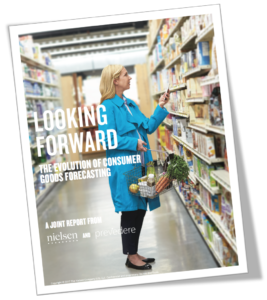Last Updated: January 29, 2021
The good news, the U.S. consumer is strong. According to a recent Forbes article featuring Andrew Duguay a senior economist at Prevedere, from February to March of this year, personal income economic indicators increased 0.3% and consumer spending rose 0.4%, buoying consumer sentiment to the highest levels since 2004. The growth of consumer spending power may be perceived as good times ahead for consumer packaged goods (CPG) brands. However, in reality, this may not always be the case.
Regardless of the strength of the consumer economic indicators today, CPG brands will continue to struggle with the volatile demand that has plagued the industry since the financial crisis of 2008. And, while the March numbers were strong, January and February were below average. With the added disruption and volatility to the industry, the need to look beyond last month’s numbers to determine future spending is more important than ever. Understanding economic indicators that drive future consumer behavior will be critical for CPGs to achieve sales goals and profit margins and strengthen retailer relations amidst this time of uncertainty.
Why A Strong Consumer Does Not Necessarily Translate To Growth For CPGs
Many CPG companies devote the majority of their resources to marketing, promotions, pricing, etc. However, some unexplainable misses in share, promotions or innovation could be explained by what is happening to the consumer when they aren’t in the store buying your product. Even so, many CPG brands continue to plan for the future by analyzing historical trends and internal metrics that may not account for important economic indicators and external influences on the consumer.
The fact is that no matter how much people love a product or brand, they won’t buy unless they have the means to do so. This is a factor of how much they are earning, whether or not they are employed, other costs that impact discretionary spending and other priorities when it comes to spending their hard-earned money.
Three Income Economic Indicators CPGs Should Be Tracking
There are hundreds of potential economic indicators that could be used to understand consumer behavior, and the task to pick the most impactful ones can be daunting. As an economist working with many CPG companies and retailers to understand the drivers of their business, I have repeatedly seen the following three indicators related to income and wages be highly predictive, accurate and repeatable, as income plays a significant role in understanding consumer purchasing decisions.
***
To help FMCG companies determine why they grew or experienced a decline and how to capitalize on opportunities ahead, Prevedere teamed up with Nielsen to create a joint report address the critical questions on the evolution of consumer goods forecasting. Download it here.
